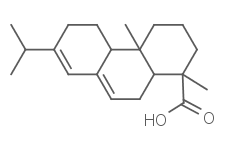
Abietic Acid
CAS No. 514-10-3
Abietic Acid( 2-ODA )
Catalog No. M18697 CAS No. 514-10-3
Abietic Acid is the primary component of resin acid isolated from rosin.
Purity : >98% (HPLC)
 COA
COA
 Datasheet
Datasheet
 HNMR
HNMR
 HPLC
HPLC
 MSDS
MSDS
 Handing Instructions
Handing Instructions
| Size | Price / USD | Stock | Quantity |
| 100MG | Get Quote | In Stock |


|
| 200MG | Get Quote | In Stock |


|
| 500MG | Get Quote | In Stock |


|
| 1G | Get Quote | In Stock |


|
Biological Information
-
Product NameAbietic Acid
-
NoteResearch use only, not for human use.
-
Brief DescriptionAbietic Acid is the primary component of resin acid isolated from rosin.
-
Description2-ODA inhibitor of Plasmodium infections.
-
In Vitro——
-
In Vivo——
-
Synonyms2-ODA
-
PathwayOthers
-
TargetOther Targets
-
RecptorMMP-1| PPARα| PPARγ
-
Research AreaOthers-Field
-
Indication——
Chemical Information
-
CAS Number514-10-3
-
Formula Weight302.45
-
Molecular FormulaC20H30O2
-
Purity>98% (HPLC)
-
SolubilityIn Vitro:?DMSO : 100 mg/mL (330.63 mM)
-
SMILESCC(C)C1=CC2=CC[C@@H]3[C@@]([C@H]2CC1)(CCC[C@@]3(C)C(=O)O)C
-
Chemical Name2-Octadecynoic Acid
Shipping & Storage Information
-
Storage(-20℃)
-
ShippingWith Ice Pack
-
Stability≥ 2 years
Reference
1. Jeon Y, et al. Exp Dermatol. 2015 Feb;24(2):140-5.
molnova catalog



related products
-
Angiotensin 1 Human
Angiotensin 1 (Human) is the precursor to the vasoconstrictor peptide angiotensin II, cleaved by the angiotensin-converting enzyme (ACE).Angiotensin is a peptide hormone that causes vasoconstriction and an increase in blood pressure.
-
Terpineol
Terpineol is a natural productused for making essence.
-
Loganic acid 6′-O-β-...
8-Epi-Loganic acid-6'-O-β-D-glucoside is a natural product from Cistanche deserticola Ma.



 Cart
Cart
 sales@molnova.com
sales@molnova.com


